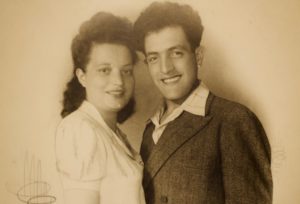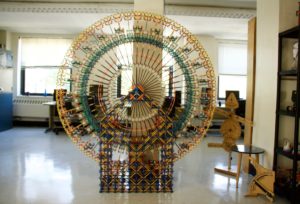Posted on 19 October 2016.
It’s more difficult than it used to be for Sally Schulman, 93, one of the few Holocaust survivors left in the Pelham Parkway area of the Northeast Bronx, to observe the Sabbath.
If it rains on Saturday, the pavement becomes too slippery for her to walk the five minutes from her apartment to the Sons of Israel Congregation down the block. Schulman recently had open-heart surgery and needs a walker and caregiver to accompany her. Hailing a cab is not an option, because driving on Shabbat is prohibited.
During the day, two caregivers cycle in and out. Still, early morning services at the orthodox synagogue often begin before help arrives. But on Yom Kippur, the Jewish Day of Atonement and Sabbath of all Sabbaths, Schulman was allotted one caregiver to spend the full day with her in temple. “We stayed from 9 a.m. to 3 p.m., and I prayed,” she said.
The following afternoon, Schulman rested at her kitchen table, smoothing the wrinkles in an embroidered white tablecloth. A 23-year-old home care aide checked the freshness of noodles in a plastic container from the fridge and decided they hadn’t gone bad. She mixed leftover meat sauce with the cold noodles in a saucepan, and headed for the door. Placing meat in a dairy pan breaks the rules of Kosher. Annoyed, Schulman discovered the offense 20 minutes later and rummaged through her cabinet looking for the appropriate kosher pot.
Observing Kosher and the strict rules of the Sabbath is harder than ever for Schulman, especially since she’s nearly alone. The Allerton neighborhood in Pelham was once a thriving Jewish community and destination spot for European Jews fleeing the horrors of World War II.
“A lot of survivors are mad at God,” said Schulman, who lived in the Jewish ghetto in her Polish village after the Soviet Invasion in 1939. “But I promised myself that I’d still believe, if I survived. I promised myself that I’d observe like my parents observed.”
In 1923, there were 3,000 Jews living in Pelham Parkway, according to a 1959 study by the Federation of Jewish Philanthropies of New York. After the war in 1950, the number of Jews in Pelham Parkway skyrocketed to 59,000. During that time, synagogues, kosher delis and restaurants populated the blocks. Today, one kosher market and a handful of Synagogues remain in the neighborhoods bordering Schulman’s apartment. In 2011, the Jewish Community Study of New York reported that only 18,300 Jews were left in Community Board 11, which encompasses nearly the entire Northeast Bronx, including Pelham Parkway, Allerton, Morris Park, Pelham Gardens, Parkchester, Baychester, and Williamsbridge.
“The elderly moved to Florida, and the young people don’t like the Bronx anymore,” Schulman said. She has lived in the Bronx for most of her adult life, since first arriving from Europe at age 26 in 1949.
Sally Bardach was born in 1923 in a small Polish town that no longer exists called Peremyshlyay, located in what is now considered western Ukraine. Sally remembered the leather and shoe store her parents owned and the school lessons with classmates. “I had a happy life then,” she said. But in 1939, when she was 16 years old, she began to notice a shift. “I didn’t understand discrimination, but I felt the change in 1939. People began to think that the Jews controlled everything. We didn’t know what was happening.”
After Soviet troops invaded the town, Sally’s family was rounded up in a Jewish ghetto. “We worked in the ghetto,” she said. “We built roads. It was very hard work.” Her parents and her four younger siblings were all together in the ghetto until German soldiers arrived in 1941. That’s when men aged 50 to 60, including Sally’s father, were taken to a gymnasium in the middle of the town. Ukrainian police and SS soldiers gave each of the 500 men a shovel and instructed them to dig one grave. “As soon as they finished digging the grave, they shot them.”
Soon after, Sally was sent to a labor camp for women called Kurowice, but her mother and younger siblings remained in the ghetto. Most prisoners in Kurowice died from overwork, starvation, disease, and systematic murder, but a handful of women survived.
During one weekend, the camp’s Judenrat, a Jewish intermediary appointed by the camp to help govern the prisoners, escorted Sally back to Peremyshlyay, claiming that she earned a weekend visit with her family. Once she arrived, she found the ghetto completely liquidated and a state of Judenrein ‑ free of Jews ‑ had been declared. Her mother had been killed, but her three brothers — Benjamin, Shaul, and Mochele — had escaped and were hiding in the forest, while a shepherd in the countryside was hiding their sister Bella. Sally managed to flee from Kurowice’s Judenrat to find her brothers.
For the next year and a half, Sally and her brothers survived in the woods. “The winter was the worst to lay in the pits,” she said. At one point, they built a bunker underground, making a small opening in a local church garden for air.
Sally recalled how her middle brother coincidentally reunited with their sister Bella in the woods after she’d been hiding with the shepherd for about a year. Benjamin arranged a meeting time between Bella and Sally the next night. “I never expected that I would live to see her,” said Sally. The danger of sneaking into the woods at night to see Bella “was one of the worst moments and one the best.”
Schulman relived the stress and agony as she recounted these stories from her Allerton kitchen table. Veiny red splotches formed on her cheeks. Her failing greenish eyes were glassy as she wrestled through the words.
All three of Sally’s younger brothers were killed one month before the liberation in 1944. “All in one day,” she said. Schulman and her brothers were together when they heard gunshots in the woods. “They tried to run in the opposite direction, but they landed right into the hands of the SS. The youngest were twins. They were seven. My middle brother was 15 or 16.” Sally got away.
When she spoke of one elderly shepherd who led her over a creek to safety in the outskirts of Peremyshlyay, her face softened. “He saved me,” she said.
After the war ended, Sally was detained in a “Displaced Persons” camp in Bavaria called Bad Reichenhall, which housed several thousand liberated Jews between 1945 and 1951. Her sister Bella, who survived in hiding, was also sent to the same camp. While there, Sally met Joseph Schulman, a survivor from a Polish town called Podhajce in what is also now considered western Ukraine.
Sally and Joe married in an improvised ceremony in the Displaced Persons camp with 10 guests in 1946. Immediately after the service, Sally gave her blue lace wedding dress to a friend, who in turn gave it to another friend. “We all got married that same day in the same dress and white hat,” Schulman said. She said she has the photos, but was unable to find them. They are the only pictures she has from the first 26 years of her life.
“No pictures,” Schulman said, “no letters, nothing.” Briefly before she was sent to DP, Schulman saw what was left of her home. “They took everything. Even the wood from the front steps was gone.” When she boarded a boat to America with her new husband in 1949, Schulman had nothing.

Holocaust survivors Sally and Joseph Schulman as younger newlyweds living in the Bronx.
The Schulmans fled to the Bronx because Joseph had an uncle working in real estate and offered to help arrange an apartment for them. Once they arrived, she was again reunited with her sister Bella, who caught a boat out of Europe one year earlier. A few years later in Brooklyn, Bella married Sam Stermer, also a Holocaust survivor and subject of the 2012 docudrama No Place on Earth, about a group of Jews who survived the war living in Ukrainian caves. “I was crying at my sister’s wedding because no one from my family was there,” said Schulman.
Joseph’s relatives in the Bronx counseled Schulman not to cry so much while integrating into her new Pelham Parkway community. They also advised against speaking about her past. “In the beginning, we were choking. Nobody wanted to hear,” she said.
Bella and Sam moved to Montreal, but Sally and Joseph remained in the Bronx. The couple ran a butcher shop together with Joseph’s brother Marcus from 1955 to 1990. “Schulman Brothers” on Pelham Parkway’s Lydig Avenue was closed every Shabbat. The Schulmans began to build their business, but there was lots of competition and life was not easy, Shulman said. “It was very hard. But we survivors were always looking forward.” And they relied on each other.
“Robert once said to me that we were the most devoted of couples. I loved him with all my strength,” Schulman said. Robert is Robert Leibowitz, her social worker. He works for a city contracted nonprofit agency called Selfhelp. According to its website, the organization has served Holocaust survivors in America for the last 75 years, currently operating programs and offices from 35 locations in Queens, Nassau County, Brooklyn, Manhattan, Long Island, and the Bronx. A 15-person Board of Trustees governs the Selfhelp Community Services Foundation to promote philanthropy and collect funds to maintain programs including senior centers, affordable senior housing, home health care, and Nazi victim services.
As part of a Nazi victims services program, Leibowitz organizes a monthly Holocaust survivor support group in Pelham Parkway’s Bronx House. Hung in Schulman’s apartment is a photo of five other survivors with Schulman at an organized lunch several years ago. “They are all gone now,” said Schulman addressing at the photograph. “Except her,” she said pointing at one woman on the far left of the photo. “I think she’s still alive.” Schulman said that eight or nine survivors participate in Leibowitz’s meetings today.
The Conference on Jewish Material Claims Against Germany recently reported that 100,000 Jews who survived the Holocaust are alive today. To preserve a human record is why Schulman shares her memories, “until books and films are all that’s left.”
But it took 40 years of living in the Bronx before Schulman decided to speak openly. When researchers from Yale University went to Queens in 1989 to record survivor accounts, Schulman traveled to meet them and offer her testimony. Today, she has the support from Leibowitz and the survivor group meetings, but Schulman says she is still prone to nightmares. “It’s been so many years, but the pain is the same.”
After retiring and closing the butcher store, the Schulman couple volunteered together in the Jacobi Medical Center gift shop, and Sally designated time to visit and cook for sick Holocaust survivors in and out of the hospital. “All my life, I’ve tried to help,” she said.
Hung on the walls of her apartment and among framed photos on her mantel are awards and plaques from various Jewish organizations engraved with Joseph’s name. Several awards from the Educational Jewish Center, the synagogue the couple once belonged, are on display.
After Joseph died in 2010, and their synagogue closed, Schulman joined the Sons of Israel Congregation. Led by Rabbi Mosche Fuchs, the congregation consists of roughly 75 members, mostly Russian immigrants who fled communism in the 1990s. In the congregation, Schulman is the only Holocaust survivor.

Sally Schulman looks at the last photo taken of her husband, Joseph Schulman, a Holocaust survivor who died in 2010.
During services, Fuchs speaks Yiddish to communicate with the attendees, though it’s unclear whether the Russians understand the language. Schulman, who speaks Yiddish, as well as Polish, Hebrew, Russian, and English, said that Fuchs offers provisions to the Russians, such as food, clothing, and money. “He helps the community,” she said. Schulman stresses the importance of community dedication. “How else can you share with people as fellow people?”
She has no family left living in the Bronx and Schulman’s closest relatives are in Connecticut and New Jersey. Her sister Bella still lives in Montreal, but she is sick with dementia. “Sometimes she talks and sometimes she is completely blacked out,” Schulman said. After 64 years of marriage, Bella’s husband Sam died this past summer. Together they have two children and six grandchildren.
“I didn’t want children because I was afraid they’d be taken from me,” Shulman said.
Today, she relies on visits from her friends’ children, two of whom recently joined Schulman for Rosh Hashanah dinner, bringing her Matzo ball soup, honey cake, and babka. She received phone calls from nieces and nephews and decorated her living room coffee table with seven New Years cards from the children of different friends.
When Joseph died, Schulman’s niece Lila Simco asked her to move to Montreal to be closer to Bella and the extended family, but Schulman wouldn’t leave the Bronx. “Not without Joe,” she said. “I’m not going anywhere. I will die in this apartment.”
On the Sunday evening before Sukkot, a celebratory holiday after the solemn Yom Kippur, a half-eaten potato kugel remained in Schulman’s kitchen. Her caregiver’s afternoon shift ended and she needed someone to light the candles because she can no longer see well enough or steady her hand to do so herself.
“I’ll say the blessing after you leave,” she said to me once the candles were lit. “Make sure you write how we survived,” she added, walking me to the door before she was left to recite the Sukkot blessings alone.








